5000 kilometers of New Zealand in two-and-a-half weeks
A few years ago Pat and Sherron Lynch presented a program at Three Rivers Birding Club about their trip to New Zealand.
This inspired Karen and me to move New Zealand up a few notches on our list of places to visit.
I was surprised when I checked to see if we could use some airline miles to make a trip over Thanksgiving.
Contrary to what one of the obnoxious television commercials would make you think – the answer was YES.
It included some longer than desired layovers in Los Angeles; but the answer was yes.
We scheduled our trip (11- to 29-Nov-2005) to try to maximize our chances to see
three penguin species during their breeding seasons. There are great resources on
the internet for planning birding trips. With borrowed books from the Lynches and
hours of on line time, we had a fairly strict schedule to visit numerous sites on
both the South and North Islands in two-and-a-half weeks. We picked up a few tips;
such as there is no drop off charge for most rental cars if you pick-up at Christchurch
and drop-off at Auckland – rental cars tend to migrate south. We had reservations
for about a third of the nights.
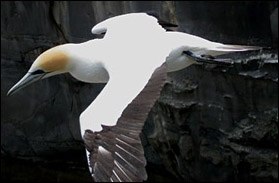 One of the highlights was a night cruise on Milford Sound.
On the cruise we saw about a dozen Fiordland Penguins. They are the most rare of
the penguin species with an estimated population of 3000 pairs. At Bluff we stayed
at a B&B at the very end of Highway 1 and were treated to Yellow-eyed Penguin
from our window the next morning.
One of the highlights was a night cruise on Milford Sound.
On the cruise we saw about a dozen Fiordland Penguins. They are the most rare of
the penguin species with an estimated population of 3000 pairs. At Bluff we stayed
at a B&B at the very end of Highway 1 and were treated to Yellow-eyed Penguin
from our window the next morning.
We had reserved a space on a pelagic trip from Kaikoura. Forty-knot winds caused
it to be canceled. The winds were fierce enough to slow the ferry from the South
Island to the North Island by about half-an-hour. This is a ferry that carries railroad
cars as well as automobiles and passengers.
The next day the winds had dropped enough for the trip to overnight on Kapiti Island.
Kapiti is one of the islands where the introduced predators have been eliminated
and endangered endemic species reintroduced. Some of the ones we saw were Takahe,
Saddleback, and Stitchbird. On Kapiti we went on a night hike and saw Little Spotted
Kiwi and close views of Little Penguin.
We had reservations for an intermediate and our last night at Miranda Shorebird
Center. It is a real bargain and allows you to schedule to
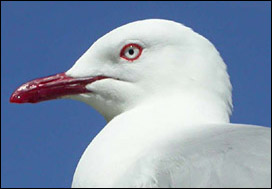 be at the hide at high tide. The Pacific Golden Plovers, Curlew Sandpipers, Sharp-tailed
Sandpipers, Pectoral Sandpipers, Red-necked Stints, thousands of Red Knots, and
thousands of Bar-tailed Godwits had just migrated from Alaska and Siberia — some
non-stop. They joined the endemic Wrybills, Variable Oystercatchers, and New Zealand
Dotterels in concentrating on the shell banks when high tide floods their feeding
flats.
be at the hide at high tide. The Pacific Golden Plovers, Curlew Sandpipers, Sharp-tailed
Sandpipers, Pectoral Sandpipers, Red-necked Stints, thousands of Red Knots, and
thousands of Bar-tailed Godwits had just migrated from Alaska and Siberia — some
non-stop. They joined the endemic Wrybills, Variable Oystercatchers, and New Zealand
Dotterels in concentrating on the shell banks when high tide floods their feeding
flats.
Another windy day canceled the scheduled ferry run to Tiritiri Matangi Island —
another predator free reserve. We’ll have to come back to visit it.
We also overnighted on Aroha Island where another night hike yielded Brown Kiwi.
The Fantails there were especially friendly, active, and enjoyable. They earned
my vote for congeniality.
The Australasian Gannet colony at Muriwai was really a
treat with views down onto the rocks covered with adults and fuzzy chicks on 18”
centers and almost stationary views of adults flying by into the wind close enough
to fill your binocular field. I could have stayed for days watching and photographing.
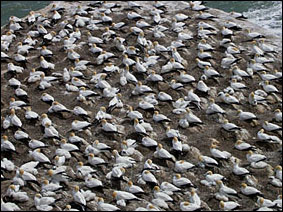 New Zealand is a very friendly and easy place to travel and bird. Today they are
doing an excellent job to protect and reintroduce many of the endemic birds nearly
made extinct by introduced predators, timbering and agriculture. In the 1862 to
1874 period, the Acclimatisation Societies introduced numerous European species
that settlers missed from their old homes. Blackbirds, Song Thrushes, Yellowhammers,
Skylarks, Starlings, Rock Pigeons and House Sparrows now abound. An interesting
phenomenon currently occurring is the self-introduction of Australian birds. Black
Swans and Welcome Swallows were not there 30 or 40 years ago. Nature changes – she
always will.
New Zealand is a very friendly and easy place to travel and bird. Today they are
doing an excellent job to protect and reintroduce many of the endemic birds nearly
made extinct by introduced predators, timbering and agriculture. In the 1862 to
1874 period, the Acclimatisation Societies introduced numerous European species
that settlers missed from their old homes. Blackbirds, Song Thrushes, Yellowhammers,
Skylarks, Starlings, Rock Pigeons and House Sparrows now abound. An interesting
phenomenon currently occurring is the self-introduction of Australian birds. Black
Swans and Welcome Swallows were not there 30 or 40 years ago. Nature changes – she
always will.
We put over 5000 kilometers on our rental car – that would have been half way back
across the Pacific to Los Angeles. New Zealand may only be the area of Colorado
– but its very long – especially when you are driving on the other side of the road.
The roads were in excellent repair but the topography dictates that they are very
many tight, slow curves. It’s not a place to be in too much of a hurry. The scenery
is spectacular. Karen and I are ready to return anytime. We’ve got to go back on
less windy days to see some birds we missed. We saw 96 species of which 69 were
lifers for Karen. Going on an organized trip would have been a lot easier; and we
would have ticked a few more birds. I don’t think we would have studied so hard,
however. I think we learned a lot more going on our own.
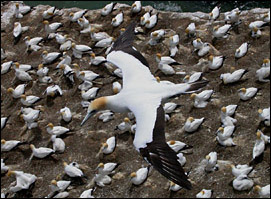 An interesting sidelight was on our second day. We were driving across Arthur’s
Pass to the west coast of the South Island. We stopped at a pull-off to scan a lake
where another couple had a scope set-up. One of them was Tony Pym who leads birding
trips for one on the British tour companies. About a week before he had held New
Zealand Storm-petrel. Over the last few years some birds had been seen over the
Hahauraki Gulf that were suspected as been New Zealand Storm-petrels, however the
last reported sightings were in 1880 and there are only three skins in museums world-wide.
One landed on a fishing boat where a crewmember recognized it as being different.
Tony and some other pelagic bird experts rendezvoused with the fishing boat the
next day to measure and photograph the bird and take DNA samples before releasing
it. He was still on such a high when we met him. That’s one for which we can go
back. — by Bill Parker
An interesting sidelight was on our second day. We were driving across Arthur’s
Pass to the west coast of the South Island. We stopped at a pull-off to scan a lake
where another couple had a scope set-up. One of them was Tony Pym who leads birding
trips for one on the British tour companies. About a week before he had held New
Zealand Storm-petrel. Over the last few years some birds had been seen over the
Hahauraki Gulf that were suspected as been New Zealand Storm-petrels, however the
last reported sightings were in 1880 and there are only three skins in museums world-wide.
One landed on a fishing boat where a crewmember recognized it as being different.
Tony and some other pelagic bird experts rendezvoused with the fishing boat the
next day to measure and photograph the bird and take DNA samples before releasing
it. He was still on such a high when we met him. That’s one for which we can go
back. — by Bill Parker



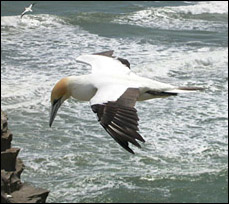
 One of the highlights was a night cruise on Milford Sound.
On the cruise we saw about a dozen Fiordland Penguins. They are the most rare of
the penguin species with an estimated population of 3000 pairs. At Bluff we stayed
at a B&B at the very end of Highway 1 and were treated to Yellow-eyed Penguin
from our window the next morning.
One of the highlights was a night cruise on Milford Sound.
On the cruise we saw about a dozen Fiordland Penguins. They are the most rare of
the penguin species with an estimated population of 3000 pairs. At Bluff we stayed
at a B&B at the very end of Highway 1 and were treated to Yellow-eyed Penguin
from our window the next morning.  be at the hide at high tide. The Pacific Golden Plovers, Curlew Sandpipers, Sharp-tailed
Sandpipers, Pectoral Sandpipers, Red-necked Stints, thousands of Red Knots, and
thousands of Bar-tailed Godwits had just migrated from Alaska and Siberia — some
non-stop. They joined the endemic Wrybills, Variable Oystercatchers, and New Zealand
Dotterels in concentrating on the shell banks when high tide floods their feeding
flats.
be at the hide at high tide. The Pacific Golden Plovers, Curlew Sandpipers, Sharp-tailed
Sandpipers, Pectoral Sandpipers, Red-necked Stints, thousands of Red Knots, and
thousands of Bar-tailed Godwits had just migrated from Alaska and Siberia — some
non-stop. They joined the endemic Wrybills, Variable Oystercatchers, and New Zealand
Dotterels in concentrating on the shell banks when high tide floods their feeding
flats. New Zealand is a very friendly and easy place to travel and bird. Today they are
doing an excellent job to protect and reintroduce many of the endemic birds nearly
made extinct by introduced predators, timbering and agriculture. In the 1862 to
1874 period, the Acclimatisation Societies introduced numerous European species
that settlers missed from their old homes. Blackbirds, Song Thrushes, Yellowhammers,
Skylarks, Starlings, Rock Pigeons and House Sparrows now abound. An interesting
phenomenon currently occurring is the self-introduction of Australian birds. Black
Swans and Welcome Swallows were not there 30 or 40 years ago. Nature changes – she
always will.
New Zealand is a very friendly and easy place to travel and bird. Today they are
doing an excellent job to protect and reintroduce many of the endemic birds nearly
made extinct by introduced predators, timbering and agriculture. In the 1862 to
1874 period, the Acclimatisation Societies introduced numerous European species
that settlers missed from their old homes. Blackbirds, Song Thrushes, Yellowhammers,
Skylarks, Starlings, Rock Pigeons and House Sparrows now abound. An interesting
phenomenon currently occurring is the self-introduction of Australian birds. Black
Swans and Welcome Swallows were not there 30 or 40 years ago. Nature changes – she
always will.  An interesting sidelight was on our second day. We were driving across Arthur’s
Pass to the west coast of the South Island. We stopped at a pull-off to scan a lake
where another couple had a scope set-up. One of them was Tony Pym who leads birding
trips for one on the British tour companies. About a week before he had held New
Zealand Storm-petrel. Over the last few years some birds had been seen over the
Hahauraki Gulf that were suspected as been New Zealand Storm-petrels, however the
last reported sightings were in 1880 and there are only three skins in museums world-wide.
One landed on a fishing boat where a crewmember recognized it as being different.
Tony and some other pelagic bird experts rendezvoused with the fishing boat the
next day to measure and photograph the bird and take DNA samples before releasing
it. He was still on such a high when we met him. That’s one for which we can go
back. — by Bill Parker
An interesting sidelight was on our second day. We were driving across Arthur’s
Pass to the west coast of the South Island. We stopped at a pull-off to scan a lake
where another couple had a scope set-up. One of them was Tony Pym who leads birding
trips for one on the British tour companies. About a week before he had held New
Zealand Storm-petrel. Over the last few years some birds had been seen over the
Hahauraki Gulf that were suspected as been New Zealand Storm-petrels, however the
last reported sightings were in 1880 and there are only three skins in museums world-wide.
One landed on a fishing boat where a crewmember recognized it as being different.
Tony and some other pelagic bird experts rendezvoused with the fishing boat the
next day to measure and photograph the bird and take DNA samples before releasing
it. He was still on such a high when we met him. That’s one for which we can go
back. — by Bill Parker


